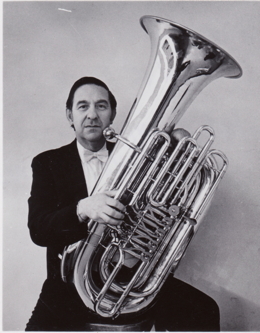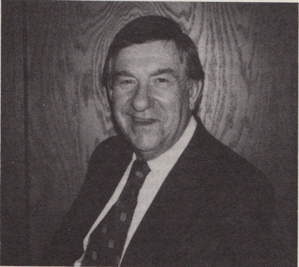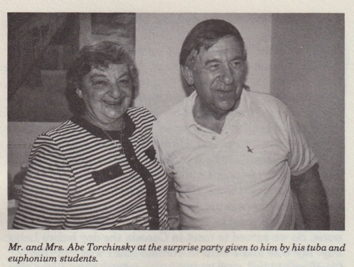Tel: +1 469 836 2108 | Email : drobnakbrass@gmail.com | Login
Abe Torchinsky (1920-2009)
Principal Tubist of the Philadelphia Symphony Orchestra
Abe Torchinsky was born March 30th, 1920 to parents who had escaped Tzarist Russia and settled in Philadelphia, Pennsylvania. He began playing tuba in a Boy Scout band and attended a vocational high school with an excellent music department. He began studying with the slightly older Arnold Jacobs while Jacobs attended the Curtis Institute of Music. Mr. Torchinsky found professional employment while still in high school, and played with the Isham Jones Orchestra and the Southern Symphony.
In Philadelphia, there were other performance opportunities, often with dance bands, playing tuba and bass. He speaks of the recording scene in Camden, New Jersey in the early years, and how Fred Pfaff, for example, would play the bass parts on Mozart symphonies, etc. on tuba for recording sessions, because the recording technology of the era would not pick up the sound of the double bass.
Mr. Torchinsky only had a short period of study at the Curtis Institute with Philip Donatelli as the wind department of Curtis was shut down at the beginning of World War II. After the school was closed, Torchinsky played with the National Symphony Orchestra for one season (1942-1943), and then moved to New York City to continue study with William Bell. He performed in the original cast productions of Billy Rose’s Seven Lively Arts, and Rogers and Hammerstein’s Carousel and Allegro, and was in the cast of the movie Carnegie Hall. He performed with the Cities Service Band of America under Paul Lavalle, and the N.B.C. Symphony with Arturo Toscanini (1946-1949).
New York is where Torchinsky found the King tuba he used for his entire career. He also acquired a Conn tuba which he later sold to Harvey Phillips. He used a few other instruments in the Orchestra, including a King tuba in E-flat made for William Bell, a Meinl-Weston F and a French tuba in C.
Hindemith Sonate Movement I

Abe Torchinsky

Photo by Joe DeMarsh
In Philadelphia, Torchinsky replaced his retired teacher, Philip Donatelli. Eugene Ormandy ran the Philadelphia Orchestra like a dictatorship, and his power extended even to being able to influence Columbia Records to recall a “jazzy” recording by the Philadelphia Brass Ensemble, Catch the Brass Ring. A later recording by the group, The Glorious Sound of Brass earned a Grammy nomination. In addition to talking about the Philadelphia Brass Ensemble recordings, Torchinsky tells backstage stories of recording the famous Gabrieli album with the Philadelphia, Chicago and Cleveland Brass Ensembles.
This interview contains stories of Toscanini, Ormandy, and other conductors Torchinsky played under in the N.B.C. Symphony and the Philadelphia Orchestra. He talks of some of his fellow musicians in the two orchestras, and of experiences on international tours.
After retiring from the Philadelphia Orchestra, Torchinsky accepted a teaching position at the University of Michigan, and taught there from 1972-1989. During this time he recorded the Hindemith Sonate with Glenn Gould. He mentions some of his students at the University of Michigan, and of his fellow faculty members. As of 2000, Mr. Torchinsky was still teaching tuba in the summer at Aspen.
Mr. Torchinsky has contributed a considerable body of scholarly publications to the tuba world, including editing “lost” duets for ophicleide, and warm-ups by William Bell. Most significantly, he produced a series of books of orchestral repertoire for tubists including the full part, not mere isolated excerpts. He describes how he spent many hours in the Edwin A. Fleisher Collection of Orchestral Music at the Free Library of Philadelphia researching scores. The repertoire books contain not only the fully reproduced parts, but commentary on the music and performance notes based on his research and a lifetime of experience.
References:
Hauprich, Donna J. “Tuba Profile: Abe Torchinsky.” T.U.B.A. Journal, Fall 1978, 2-5.
Maldonado, Luis. “A Conversation with Abe Torchinsky,” 17-21, in “A. T.U.B.A. Tribute to Abe Torchinsky,” T.U.B.A. Journal, Summer 1989, 16-24.
Morris, R. Winston, and Goldstein, Edward R., eds., The Tuba Source Book. Bloomington, Indiana: Indiana University Press, 1996, 515, passim.
Torchinsky, Abe. “Tuba Trends.” The Instrumentalist 18 (April, 1964): 86-87.
Obituary in The Philadelphia Inquirer

Photo by Joe DeMarsh
Help support this website by buying me a coffee!
Biography
Abe Torchinsky, a native of Philadelphia began playing tuba in a Boy Scout band. In 1935 he began taking lessons with a young student at the Curtis Institute named Arnold Jacobs. By the time he was in high school, he was performing professionally on tuba and bass, even playing with Isham Jones Orchestra. He enrolled at Curtis in 1940 and studied with Philip Donatelli, the tubist of the Philadelphia Orchestra until the wind department at the Institute was shut down at the beginning of World War II.
Mr. Torchinsky played in the Southern Symphony Orchestra and with the National Symphony Orchestra for one season (1942-1943). He then moved to New York City for concentrated study with William J. Bell. He performed in the original cast productions of Billy Rose’s Seven Lively Arts, and Rogers and Hammerstein’s Carousel and Allegro, and was in the cast of the movie Carnegie Hall. He performed with the Cities Service Band of America under Paul LaValle, and the NBC Symphony with Arturo Toscanini (1946-1949).
Torchinsky joined the Philadelphia Orchestra in 1949, and served as principal tuba until 1972. Mr. Torchinsky and trombonist Henry Charles Smith hosted a radio program about the orchestra. After retiring from the Philadelphia Orchestra, Torchinsky became a member of the faculty of the University of Michigan (1972-1989). A Philadelphia Brass Ensemble recording, The Glorious Sound of Brass earned a Grammy in 1967. The Philadelphia Brass Ensemble’s recording of the Antiphonal Music of Gabrieli with the Chicago and Cleveland Brass Ensembles won a Grammy in 1969. The Philadelphia Brass Ensemble as soloists were also nominated in 1976 for a two album set of Hindemith’s sonatas for brass instruments with pianist Glenn Gould.
A less-familiar, early recording called Catch the Brass Ring by the Philadelphia Brass Ensemble, masquerading as the “Torchy Jones Quintet” had the distinction of being pulled from distribution by Columbia after Eugene Ormandy objected to orchestra members making a “jazz” recording. His scholarly efforts in publishing full parts to orchestral works were an innovation and a vast improvement for students over previously available excerpt books.
-International Tuba Euphonium Association
